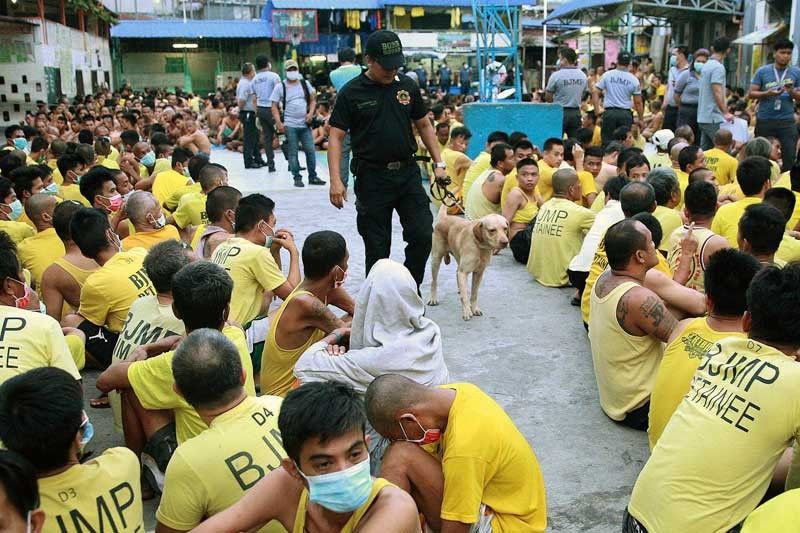Are those 11,000 reformed, or still into narco-trade?


For an administration that professedly aims to eliminate all narco-traffickers, its minions oddly were too eager to set a notorious one loose on society. High-profile convict Antonio Sanchez is in for gang rape and multiple murder. But recall the news items when he led the abduction, sexual assault, and gun slaying of two university students in 1993. He reportedly was using his position as Laguna town mayor then for illegal numbers gaming and narco-trade. If he were still in office today, he’d likely be in Rody Duterte’s blacklist of narco-politicos. Yet incredibly two presidential trusties are endorsing his speedy special parole.
Sanchez was not convicted for jueteng or drugs, or for non-filing of mandatory asset statements as a public official. Prosecutors concentrated then on the bloody crimes. His and six henchmen’s sentencing in 1995 and 1996 to nine life terms were for killing the two students and, previous to that, a father and son political rivals. (He swears innocence to this day, insisting that an unnamed political foe had framed him.)
Drugs allegedly were very much a part of Sanchez’s life. In 2006 he was caught in his prison quarters illegally possessing shabu (meth). Again in 2010, P1.5 million worth of the white powder was found hidden inside his big decorative religious statue. That much shabu was not for personal use but narco-trade. At the going rate then of P100 per gram in sachet – good for five days’ high – the stash was all of 15 kilos. From sale proceeds he likely bought favors from crooked prison guards. He lived in a special air-conditioned bungalow in the prison yard. He wore slacks, polo shirts, leather shoes, wristwatches, jewelry, and sunglasses instead of a convict’s orange uniform. Bossing other inmates, he was videoed strolling under a parasol toted by one of them. A recidivist, he hardly qualifies for the Good Conduct Time Allowance law of 2013. His privileges were all in breach of the list of 49 misdemeanors to debar a convict from GCTA. His endorsers are silent about his record of 40 rule violations ever since he was brought into the National Penitentiary in 1995. (That was disclosed by Senate Minority Leader Franklin Drilon, a former justice secretary, so has contacts in the Bureau of Corrections.)
Sanchez purportedly was in the first batch of processed parolees among 11,000 others. That’s another puzzle. The GCTA law provides for a tedious review process. A Management, Screening, and Evaluation Committee studiously must monitor and record monthly the behavior of inmates in all prisons nationwide brought in after the GCTA’s passage in 2013. Then, last June 2019, the Supreme Court ruled that the law should retroactively cover all prisoners. In the past two months the committee must have only started to create new GCTA records on the old-timers. It must have considered the octogenarians first. There were questions about whether to include heinous criminals; Justice Sec. Menardo Guevarra vehemently was against shortening their sentences. So why was multiple murderer, rapist, abductor, torturer Sanchez, now 70, in front of the line?
Public outcry, which Duterte heeded, aborted Sanchez’s release. Still suspicions have been aroused. The Senate has set an inquiry. President Duterte might wish to investigate on his own. His anti-drug war may depend on it.
For, what of the 11,000 other prospective parolees? Have they properly been vetted? Answers are crucial because of the acute drug trade inside prisons. Congressional inquiries in 2016 revealed that narco-gangs were trafficking shabu inside and outside the penitentiaries by the hundreds of millions of pesos. That’s how they were able to buy and control high Justice department and Corrections bureau officials of past administrations.
The statistics are persistent. Four of every five convicts are in for drug-related offenses, like incestuous rape or killing sprees while high on shabu. That’s 8,800 of the 11,000. Too, that two in five are for direct narco-trafficking, mostly big-time – or 2,200 of the 11,000. Philippine justice is rehabilitative rather than retributive. Have the authorities ascertained if the prospective parolees under the GCTA law are truly reformed? Have they learned new trades and skills while behind bars? Will there be relatives to accept them or jobs waiting upon their release? Or will they likely return to lives of crime – especially the easiest one: peddling shabu to millions of Filipino druggies?
* * *
Only three days left to view “Dede Land,” Pinoy sound pioneer Dennis Garcia’s swing into visual arts. Featured are paintings of the musician’s favorite female body part. Says visual artist-film director Prof. Nelson Cruz of the exhibit: “As Dennis Garcia of Hotdog, he opened our ears to the melody of jeepney horns and the rhythmic heartbeats of our first love. Now, as DeDennis Garcia of Dede Land, he unbuttons all inhibitions and unstraps all restrictions. Dede Land gets to the bosom of the Pinoy psyche and sets it free. We can only gaze, liberated and teary-eyed, as we say, thanks for the mammaries.”
Art Center, 4th Flr., SM Megamall, EDSA, Mandaluyong City.
* * *
Catch Sapol radio show, Saturdays, 8-10 a.m., DWIZ (882-AM).
Gotcha archives: www.philstar.com/columns/134276/gotcha
- Latest
- Trending


























